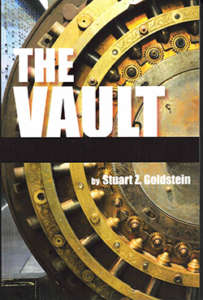By Eric George Tauber

 CINCINNATI, Ohio — Stories of a good heist excite our imaginations. The Sting, The Great Train Robbery, The Pink Panther and the Oceans movies all draw us in with their promises of daring, suspense, and cunning anti-heroes who find a way to beat the system and “stick it to the Man.” The Vault by Stuart Z. Goldstein takes us to Americlear, a fictional Manhattan brokerage.
CINCINNATI, Ohio — Stories of a good heist excite our imaginations. The Sting, The Great Train Robbery, The Pink Panther and the Oceans movies all draw us in with their promises of daring, suspense, and cunning anti-heroes who find a way to beat the system and “stick it to the Man.” The Vault by Stuart Z. Goldstein takes us to Americlear, a fictional Manhattan brokerage.
But we’re not in the boardroom with the machers in their tailored suits. We’re going underground to meet the team of worker bees who file the millions of papers like stock certificates and bearer bonds that keep the wheels of global finance turning. Tired of being treated like soulless
machines and facing potential layoffs, they cook up a plot to smuggle 100 million dollars worth of untraceable bearer bonds out of the vault. With Hurricane Sandy barreling towards New York, they’ll all be well out of the country before anyone gets wise to what’s missing. At least, that’s the plan.
We come into the vault through Stella, the newbie. It’s a common device to bring us into a story through a relatable character. In this way, we meet everyone and have things explained to us. Stella gets the details of every co-worker’s life story at the first handshake. I get that the author wants to humanize the people who are embezzling very large sums of money, but when the exposition occupies the first hundred pages, it’s a bit much.
The heart and soul of the novel is Andy Russo, Stella’s gruff but good natured boss. Russo is a loyal company man who has worked down in the vault for 40 years. A caring and protective leader to his team, he is the angriest at how capriciously his people are being treated by those who sit above like the Gods of Olympus. It’s Russo who hatches the plan and gets the others onboard. To create the character, Goldstein relies heavily on old stereotypes of working-class Italians.
Russo even has connections to the mob through “the old neighborhood.” This makes Russo sound more like he belongs in a gangster movie set in the mid-20th century than in the early 21st.
What makes The Vault different from other heist stories is that these are not career criminals. These are workaday shlubs who can never hope to own the kinds of resources they hold in their hands every day. Yet they know their business, so they know how to exploit even the smallest cracks in the wall. The plan is to take the money and get out of the country. Are they really prepared to leave and never look back? What if they get caught or even questioned? It only takes one weak link in the chain to crack under pressure and then the jig is up.
The Vault presents a heist story with relatable characters and an intriguing scenario that might actually work if they all stick together. Unfortunately, telling of it is weighed down by dated stereotypes, less than clever dialog and far too much exposition in a story that needs to heat up much faster than it does. Also this unconventional scenario begs one very important question: Who in the hell wants to read about bearer bonds in their free time? Maybe there’s a reason it’s never been done before.
Sorry, Stuart, but I have to give The Vault a hard pass.
*
Eric George Tauber is a freelance writer based in Cincinnati, Ohio. A former San Diegan, he specializes in coverage of the arts.